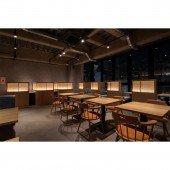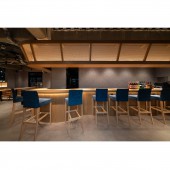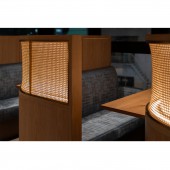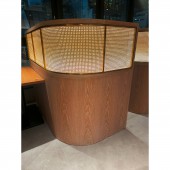
| THE AWARD |
| CATEGORIES |
| REGISTRATION |
| SUBMIT YOUR WORK |
| ENTRY INSTRUCTIONS |
| TERMS & CONDITIONS |
| PUBLICATIONS |
| DATES & FEES |
| METHODOLOGY |
| CONTACT |
| WINNERS |
| PRESS ROOM |
| GET INVOLVED |
| DESIGN PRIZE |
| DESIGN STORE |
| THE AWARD | JURY | CATEGORIES | REGISTRATION | PRESS | WINNERS | PUBLICATIONS | ENTRY INSTRUCTIONS |
Junno's Table Restaurant by Masanori Goto |
Home > Winners > Design #157027 >Interview |
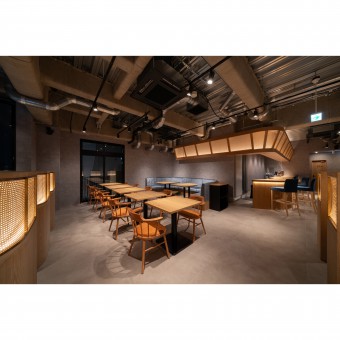 |
|
FS: What is the main principle, idea and inspiration behind your design?
MG: I prioritize the quality of materials over their color and shape. I avoid using fake materials like faux wood grain or faux leather because they can diminish the authenticity of real materials. It's akin to how a small amount of mold can spoil an entire batch of food. Genuine materials have the power to enhance a space and create a wonderful atmosphere, allowing people to feel the warmth of real wood, for example. I believe that the role of a designer is to combine these elements to improve a space and evoke emotions in those who visit it.
FS: What has been your main focus in designing this work? Especially what did you want to achieve?
MG: It was crucial to translate the client's concept into spatial design effectively. Infusing meaning into the design was pivotal for creating a compelling spatial experience.
FS: What are your future plans for this award winning design?
MG: My future plans include participating in several international awards. Recently, I was honored as a finalist for the Architizer A+ Award, a prestigious recognition among five global finalists. Additionally, I have received the 'Most Viewed & Most Popular' Award from Frame Magazine for two consecutive terms, celebrating both critical acclaim and global audience appreciation.
FS: How long did it take you to design this particular concept?
MG: It took approximately 1week for layout planning and 2-3 weeks for the detailed design phase.
FS: Why did you design this particular concept? Was this design commissioned or did you decide to pursuit an inspiration?
MG: The concept of the restaurant is 'offering fusion cuisine from various countries and Japanese culture.' Rattan is meticulously crafted one strand at a time, and I immediately realized that rattan would be suitable for expressing the words 'connection, interaction, and finesse.
FS: Is your design being produced or used by another company, or do you plan to sell or lease the production rights or do you intent to produce your work yourself?
MG: This design is exclusively for my clients.
FS: What made you design this particular type of work?
MG: Upon confirming the restaurant's concept, I conceived an original spatial design that included custom-made rattan partitions, sofas, and other elements.
FS: Where there any other designs and/or designers that helped the influence the design of your work?
MG: I don't research other designers because if I become too interested in them, I might unconsciously end up copying their designs. I do use Pinterest, but only to check if there are any designs similar to what I'm considering. If I find something similar, I change my design.
FS: Who is the target customer for his design?
MG: The main target audience for this restaurant is couples
FS: What sets this design apart from other similar or resembling concepts?
MG: Design is the magic that moves hearts, enriches minds, and transforms lives into something wonderful. Copying design lacks that power.
FS: How did you come up with the name for this design? What does it mean?
MG: It's client's Restaurant Name
FS: Which design tools did you use when you were working on this project?
MG: VectorWorks for Drawings, Sketchup and Twinmotion for 3D Design, Photoshop for Presentation.
FS: What is the most unique aspect of your design?
MG: By illuminating the rattan from within, it not only makes the space beautifully shine but also symbolizes the concept of "fusion." This is the most unique aspect of this design.
FS: Who did you collaborate with for this design? Did you work with people with technical / specialized skills?
MG: The rattan used in my design was crafted by artisans from a traditional shop in Hiroshima that has been operating since 1926. Being from Hiroshima myself, I wanted more people to know about their amazing skills and traditions. I believe that sharing such knowledge is one of the roles of interior designers and architects.
FS: What is the role of technology in this particular design?
MG: In this project, I focused on tradition, so I did not utilize technology. However, we I also interested in the fusion of tradition and technology because It's Polar opposites and intriguing.
FS: Is your design influenced by data or analytical research in any way? What kind of research did you conduct for making this design?
MG: After researching the traditions related to rattan, I was convinced that their rattan was the finest, so I used it in this project.
FS: What are some of the challenges you faced during the design/realization of your concept?
MG: A designer is not only required to create beautiful designs. It is also crucial to develop a layout that accommodates as many seats as possible within a limited space to ensure good revenue for the client. It was important to consider both of these aspects simultaneously.
FS: How did you decide to submit your design to an international design competition?
MG: I participated in the Award because I Designed beautifully illuminate rattan and created a design unlike any other.
FS: What did you learn or how did you improve yourself during the designing of this work?
MG: Interior designers need to think not just about designing a space, but also about how different layouts and functionalities can contribute to the client's benefit. I always gain new insights from my clients.
FS: Any other things you would like to cover that have not been covered in these questions?
MG: Question: Have there been any major changes since participating in the awards? Answer: I've only been on Instagram for six months, but my account has grown to 270,000 followers. I'm amazed to be followed by various celebrities and brands, such as Mark Leckey, a contemporary British artist known for his solo exhibition at Espace Louis Vuitton Tokyo and collaboration with Supreme, as well as renowned furniture brands.
FS: Thank you for providing us with this opportunity to interview you.
A' Design Award and Competitions grants rights to press members and bloggers to use parts of this interview. This interview is provided as it is; DesignPRWire and A' Design Award and Competitions cannot be held responsible for the answers given by participating designers.
| SOCIAL |
| + Add to Likes / Favorites | Send to My Email | Comment | View Press-Release |
